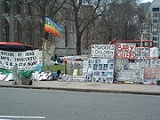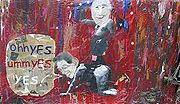
State Britain
Encyclopedia

Installation art
Installation art describes an artistic genre of three-dimensional works that are often site-specific and designed to transform the perception of a space. Generally, the term is applied to interior spaces, whereas exterior interventions are often called Land art; however, the boundaries between...
artwork by Mark Wallinger
Mark Wallinger
Mark Wallinger is a British artist, best known for his sculpture for the empty fourth plinth in Trafalgar Square, Ecce Homo , and State Britain , a recreation at Tate Britain of Brian Haw's protest display outside parliament. He won the Turner Prize in 2007...
displayed in Tate Britain
Tate Britain
Tate Britain is an art gallery situated on Millbank in London, and part of the Tate gallery network in Britain, with Tate Modern, Tate Liverpool and Tate St Ives. It is the oldest gallery in the network, opening in 1897. It houses a substantial collection of the works of J. M. W. Turner.-History:It...
in January 2007. It is a recreation from scratch of a protest display about the treatment of Iraq, set up by Brian Haw
Brian Haw
Brian William Haw was an English protester and peace campaigner who lived for almost ten years in a camp in London's Parliament Square from 2001, in a protest against UK and US foreign policy...
outside Parliament and eventually confiscated by the police. Haw's display contained several hundred items donated by members of the public. As well as continuing the protest, Wallinger's recreation in a different context also brings up questions of authenticity. Wallinger won the Turner Prize
Turner Prize
The Turner Prize, named after the painter J. M. W. Turner, is an annual prize presented to a British visual artist under the age of 50. Awarding the prize is organised by the Tate gallery and staged at Tate Britain. Since its beginnings in 1984 it has become the United Kingdom's most publicised...
in 2007 for this piece.
Description
State Britain is a meticulous recreation of a 40 metre long display which had originally been situated around peace campaigner Brian Haw'sBrian Haw
Brian William Haw was an English protester and peace campaigner who lived for almost ten years in a camp in London's Parliament Square from 2001, in a protest against UK and US foreign policy...
protest outside the Houses of Parliament against policies towards Iraq
Iraq
Iraq ; officially the Republic of Iraq is a country in Western Asia spanning most of the northwestern end of the Zagros mountain range, the eastern part of the Syrian Desert and the northern part of the Arabian Desert....
.

Banksy
Banksy is a pseudonymous England-based graffiti artist, political activist, film director, and painter.His satirical street art and subversive epigrams combine irreverent dark humour with graffiti done in a distinctive stencilling technique...
stencil of two soldiers painting a peace sign next to Leon Kuhn
Leon Kuhn
Leon Kuhn is an anti-war political cartoonist who created topical parodies in the United Kingdom and was listed as an initial supporter of Artists against the War....
's anti-war political caricature 3 Guilty Men,, both of which, together with Kuhn's The Proud Parents, Mark Wallinger
Mark Wallinger
Mark Wallinger is a British artist, best known for his sculpture for the empty fourth plinth in Trafalgar Square, Ecce Homo , and State Britain , a recreation at Tate Britain of Brian Haw's protest display outside parliament. He won the Turner Prize in 2007...
later displayed in his recreation at the Tate in 2007.
The original display, apart from a three metre section, was confiscated by the police under the Serious Organised Crime and Police Act 2005
Serious Organised Crime and Police Act 2005
The Serious Organized Crime and Police Act 2005 is an Act of the Parliament of the United Kingdom aimed primarily at creating the Serious Organised Crime Agency, it also significantly extended and simplified the powers of arrest of a constable and introduced restrictions on protests in the...
, which prohibits unauthorised protests in a specified "exclusion zone" around Parliament.
Mark Wallinger
Mark Wallinger
Mark Wallinger is a British artist, best known for his sculpture for the empty fourth plinth in Trafalgar Square, Ecce Homo , and State Britain , a recreation at Tate Britain of Brian Haw's protest display outside parliament. He won the Turner Prize in 2007...
employed 15 people for 6 months and spent £90,000 to recreate it in its entirety. It was installed inside the Duveen Hall of Tate Britain
Tate Britain
Tate Britain is an art gallery situated on Millbank in London, and part of the Tate gallery network in Britain, with Tate Modern, Tate Liverpool and Tate St Ives. It is the oldest gallery in the network, opening in 1897. It houses a substantial collection of the works of J. M. W. Turner.-History:It...
in January 2007. Signs at all the entrances to the hall warn that the exhibit contains images of extreme human suffering.
The Sunday Times saw the show as more indication that the arts establishment had turned against the Labour
Labour Party (UK)
The Labour Party is a centre-left democratic socialist party in the United Kingdom. It surpassed the Liberal Party in general elections during the early 1920s, forming minority governments under Ramsay MacDonald in 1924 and 1929-1931. The party was in a wartime coalition from 1940 to 1945, after...
government. It contrasted Tate director Sir Nicholas Serota
Nicholas Serota
Sir Nicholas Andrew Serota is a British art curator. Serota was director of the Whitechapel Gallery, London, and The Museum of Modern Art, Oxford, before becoming director of the Tate, the United Kingdom's national gallery of modern and British art in 1988. He was awarded a knighthood in 1999. He...
's endorsement of Wallinger's show with the private tour of Tate Modern
Tate Modern
Tate Modern is a modern art gallery located in London, England. It is Britain's national gallery of international modern art and forms part of the Tate group . It is the most-visited modern art gallery in the world, with around 4.7 million visitors per year...
Serota had given to Prime Minister
Prime minister
A prime minister is the most senior minister of cabinet in the executive branch of government in a parliamentary system. In many systems, the prime minister selects and may dismiss other members of the cabinet, and allocates posts to members within the government. In most systems, the prime...
Tony Blair
Tony Blair
Anthony Charles Lynton Blair is a former British Labour Party politician who served as the Prime Minister of the United Kingdom from 2 May 1997 to 27 June 2007. He was the Member of Parliament for Sedgefield from 1983 to 2007 and Leader of the Labour Party from 1994 to 2007...
in 2000. At that time Blair's government had courted Young British Artists
Young British Artists
Young British Artists or YBAs is the name given to a loose group of visual artists who first began to exhibit together in London, in 1988...
such as Tracey Emin
Tracey Emin
Tracey Karima Emin RA is a British artist of English and Turkish Cypriot origin. She is part of the group known as Britartists or YBAs ....
and Damien Hirst
Damien Hirst
Damien Steven Hirst is an English artist, entrepreneur and art collector. He is the most prominent member of the group known as the Young British Artists , who dominated the art scene in Britain during the 1990s. He is internationally renowned, and is reportedly Britain's richest living artist,...
to help "modernise" Britain.
State Britain was curated in collaboration with Wallinger by Tate curator, Clarrie Wallis. It was on show until 27 August 2007.
Wallinger was shortlisted for the Turner Prize
Turner Prize
The Turner Prize, named after the painter J. M. W. Turner, is an annual prize presented to a British visual artist under the age of 50. Awarding the prize is organised by the Tate gallery and staged at Tate Britain. Since its beginnings in 1984 it has become the United Kingdom's most publicised...
on 8 May 2007 for State Britain, and announced the winner on 3 December 2007.
Exclusion zone
The Tate press release on the exhibition mentioned that the Serious Organised Crime and Police Act 2005Serious Organised Crime and Police Act 2005
The Serious Organized Crime and Police Act 2005 is an Act of the Parliament of the United Kingdom aimed primarily at creating the Serious Organised Crime Agency, it also significantly extended and simplified the powers of arrest of a constable and introduced restrictions on protests in the...
prohibited "unauthorised demonstrations within a one kilometre radius of Parliament Square" and that this radius passed through the Duveen Hall, bisecting Wallinger's exhibit. Wallinger marked this on the floor with a black line running through the Tate. Initial press reports dwelt on the potential dangers of this infringement, speculating that the police might even remove the half of the exhibit on the "wrong side of the line". However, Charles Thomson
Charles Thomson (artist)
Charles Thomson is an English artist, painter, poet and photographer. In the early 1980s he was a member of The Medway Poets. In 1999 he named and co-founded the Stuckists art movement with Billy Childish. He has curated Stuckist shows, organised demonstrations against the Turner Prize, run an art...
of the Stuckists
Stuckism
Stuckism is an international art movement founded in 1999 by Billy Childish and Charles Thomson to promote figurative painting in opposition to conceptual art...
pointed out the exclusion zone ended at Thorney Street, 300 yards before the Tate. The one kilometre radius is the maximum possible, but not actual, area of the designated zone, which is mapped out by particular streets.
Critiques

Tim Teeman commented that Wallinger created the exhibit not only to bring what he perceives as a dangerous erosion of civil liberties to light, but also to examine whether the installation was art or politics; Teeman concluded that it was obviously both. Waldemar Januszczak
Waldemar Januszczak
Waldemar Januszczak is a British art critic. Formerly the art critic of The Guardian, he now writes for The Sunday Times, and has twice won the Critic of the Year award...
commented on "a cheeky intervention that raises lots of interesting questions," but that these were about "issues of originality and authenticity", rather than the original political intent of the display. Edward Lucie-Smith
Edward Lucie-Smith
John Edward McKenzie Lucie-Smith is a British writer, poet, art critic, curator, broadcaster and author of exhibition catalogues.-Biography:Lucie-Smith was born in Kingston, Jamaica, moving to the United Kingdom in 1946...
called it "official art" and considered that Haw, not Wallinger, should receive the credit.
External links
- Tate Britain's page on State Britain
- Review of State Britain (with pictures) by The GuardianThe GuardianThe Guardian, formerly known as The Manchester Guardian , is a British national daily newspaper in the Berliner format...
- 3D Panorama of Brian Haw's original site (requires QuickTime)
- Metropolitan Police map of the exclusion zone

